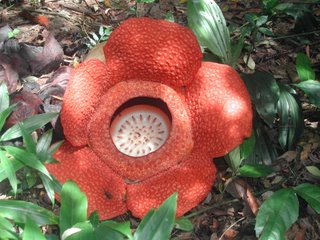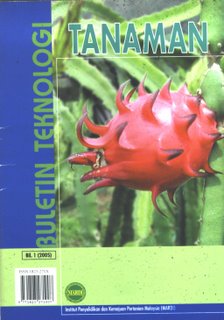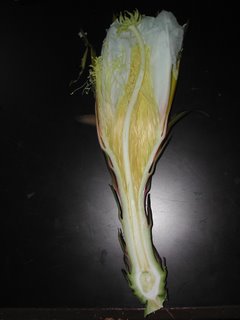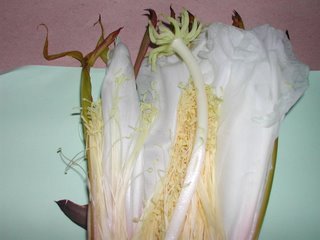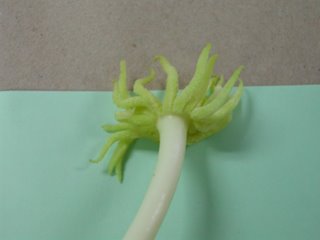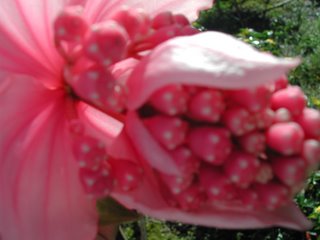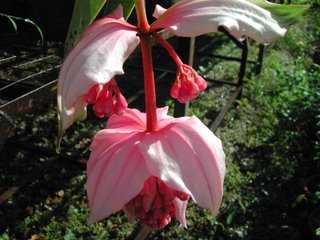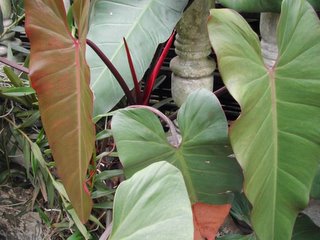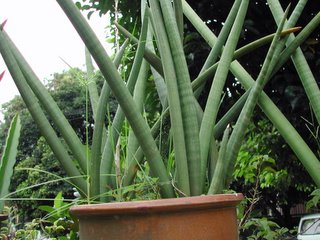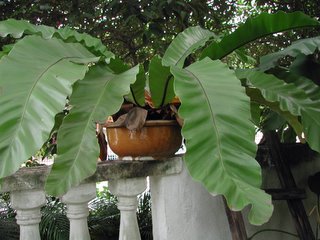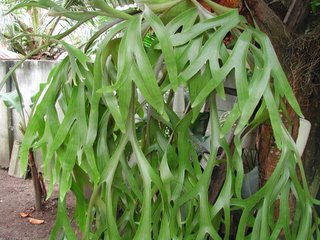Friday, December 29, 2006
M.S.T.E.(MARDI Science and Technology Exhibition) Week)
On the very morning one speaker was invited to give a talk on Knowledge Management (KM).If I am not mistaken his name was Dr.Frank Aw, young, energetic fellow around 35 years old.He gave us a 2-hour solid lecture on practice of KM. A few of his slides that I gathered on Practice On Knowledge Management (POKM) was that scientists need to have first class mentality. Right now , most Malaysians scientists or whatever, he said had third class mentality; meaning that they have to be pushed (young or old) to do work or responsibilities, job etc. However, if they or we need to move forward ahead than others than we need to have 1st class mentality.What do we mean by that ?. Scientists should have four basic characteristics inculculate in them.
1.Self-driven 2.Proactive 3.Collaborative 4.Innovative.
With this features they will able to practice KM. There are 8 principles of POKM.
1.K-identification
2.K-acquisition
3.K-application
4.K-sharing
5.K-development
6.K-creation
7.K-preservation
8.K-measurement.
Saturday, December 16, 2006
Chance for jobless grads to become rock melon farmers
CALLING jobless graduates who are interested in becoming farmers. The Cabinet has set aside 20 ha of land in Kluang, Johor, for graduates of who are interested in cultivating rock melon.
Agriculture and Primary Industries Tan Sri Muhyiddin Yassin said today that the project was being managed by the newly-formed Malaysian Graduate Entrepreneurs Association.
"I have asked the association to establish a co-operative to start clearing the land. The planting of rock melons has already started on a small scale. It is successful and I have asked that it be expanded," he said.
Muyhiddin said those interested would receive financial assistance from the Ministry.
Source:NST Dec11.2006
Friday, December 15, 2006
M.A.H.A.
Malaysian Expo Provides Opportunities for Agri Entrepreneurs
SERDANG, Nov 23 Asia Pulse Entrepreneurs who wish to venture into agriculture and agro-tourism industries can acquire vast knowledge about them at the Agriculture, Horticulture and Agro-Tourism (MAHA) 2006 Exposition, being held at the Malaysian Agro-Exposition Park, here.MAHA Expo Working Committee chairman Mohamed Shariff Abdul Aziz said this was because the expo, the biggest in South-East Asia, showcased the A to Z of various agro-based technologies.
"For instance, visitors will be exposed to value added systems, get to develop new networks with other businessmen, and gain insight on how to market their products at hypermarkets," he told Bernama when met at the expo site Wednesday.
Prime Minister Abdullah Ahmad Badawi opened the expo yesterday, in which 697 entrepreneurs and government agencies are participating.
MAHA 2006 is organised by Agriculture and Agro-Based Industry Ministry with the co-operation of the Federal Agricultural Marketing Board (FAMA) and the Malaysia External Trade Development Corporation (MATRADE).
Shariff said that visitors would also be exposed to business and investment opportunites, methods of securing loans and other aspects of the sector at a special seminar.
Foreign participants including from Yunan Province, China, are also showcasing new farming techniques at the expo.Other countries participating include Australia, India, New Zealand, Belgium, United Kingdom, Netherlands, Canada, Laos and Indonesia.
"More than 2,000 people have registered for the seminar. This is very encouraging and augurs well for future expositions," added Shariff.
(BERNAMA-OANA)
Thursday, September 14, 2006
Dragon fruits pruning
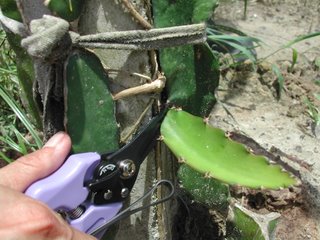
Pruning is one of the important aspects in dragon fruit planting. The purpose of prunning is to take off the unwanted branches, as well as to give balance the whole plant. If we don’t prune the plant will easily get affected by disease .
Branches which are too long should be trimmed to about 5 -10 cm from the main supporting stem. This is to encourage the new branches to grow. The specialty of this plant is that the old branches can be use to a new planting. Research shows that the length and age of the dragon fruit plant used to plant
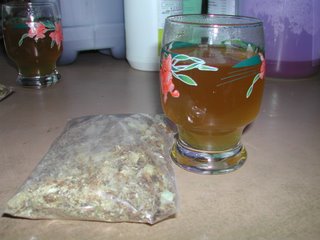 will effect the flowering process.
will effect the flowering process.Young shoots can be cooked just like we cook lady's finger.Its nutritious.There is another source vegetable which had medicinal value in our diet. The dry flowers can be processed to make tea.
Tuesday, September 05, 2006
Dragon fruits pollination
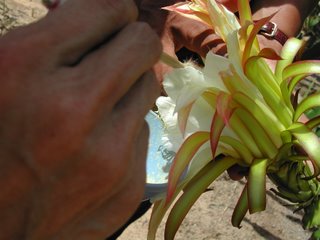
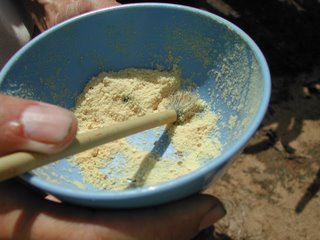
I have gone to Johore to see dragon fruits palnting. It is one of the biggest area in Malaysia which had many dragon fruits plantings; which almost 500 acres One of the interesting thing I observed was assisted pollination of dragon fruits. They taught me how to take pollens, pollen keeping, hand pollination etc. Actually the assisted pollination is done at night when the flowers bloom. Hand pollination is done between 8 to 10 p.m. Assisted pollination produced bigger fruits almost to 800 g.
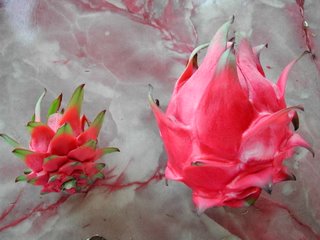
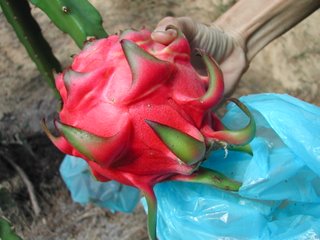
Monday, June 26, 2006
Guava
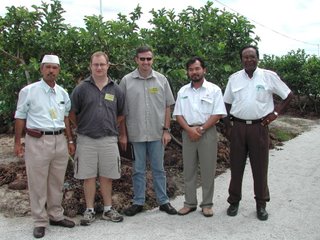
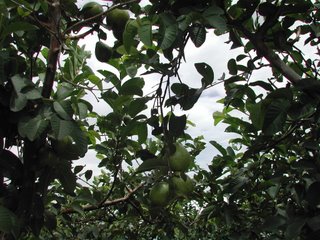
Last week I brought my mat salleh friend, Zahir and his colleague from NZ to a guava juice factory and plantations in Perak.This guava plantation is the biggest in the world which is about 1200 acres in a single plantation. We met the manager and they give us briefings on guava plantations in Perak.They planted the red variety. Their website could be reached at
http://www.ghopepuree.com/.
I try to make connection with NZ fruit exporter http://www.delica.co.nz/ in order to promote our local fruits overseas.
Besides guava, they have dragon fruits but not well maintained due to disease infestations.
Tuesday, June 13, 2006
Wednesday, May 17, 2006
IRPA -eScience
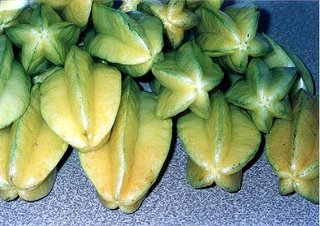
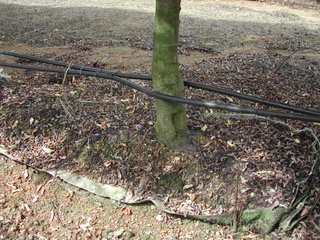

The project started in August 2002 and treatments consisted of two shapes i.e ‘V’ and rectangular; and two volumes i.e. 91- and 187-litres. The 2X2 treatment combinations and control were randomized with 6 replications. Plants were root-restricted using geotextile membrane with 100 µm porosity. Carbohydrate analysis and NPK analyses were carried out at flushing, flowering and fruiting. Results showed that all treatments had high carbohydrate level at flushing and flowering stage; 0.39 and 0.37 mg/g, respectively when compared to fruiting stage at 0.27 mg/g. While, nutrient analyses showed that N, and K contents were almost consistent at flushing, flowering and fruiting stages. This indicated that there was no nutrient deficiency symptoms detected in starfruit plants due to root suppression. It also showed that carbohydrate remains high at flushing and flowering and reduced during fruiting stage and its built- up at vegetative stage is higher than reproductive stage.
Tuesday, May 16, 2006
Write-up on dragon fruits
has been fully sold.
Tuesday, April 11, 2006
Dragon fruit flower
Wednesday, March 08, 2006
Potential Flower
Potential Plant
Tuesday, February 14, 2006
Dragon fruits
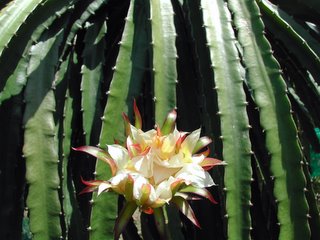
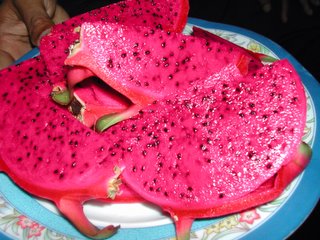
Dragon fruit is a new fruit type that has been cultivated in Malaysia and the Malaysian fruit industry began to grow rapidly after 1980. The government encouraged the development of fruit estates by providing farmers with incentives and technological back-up facilities in the growing, processing and marketing of fruits.
Malaysia is endowed with a climate which permits the cultivation of many different types of fruit. Some of the fruits grown here are native to this part of the world and many related species still grow wild in the primary forests of the country. Indigenous fruits include the mangosteen, durian, rambutan and a number of species of banana.
Malaysian fruits can be grouped into two categories: firstly, seasonal fruits which come into bearish during specific periods of the year and secondly, the non-seasonal fruits which are productive throughout the year.
In general, under prevailing climatic conditions, seasonal fruits are subject to two main reasons, the first and heavier being the period between June and August, while the second season prevails between November and February.
Traditionally, Malaysian fruits are grown on smallholdings established primarily for family consumption with any surplus sold to local markets. There are over 135,000 of these holdings in peninsular Malaysia, ranging from one to two hectares each in size. Most are planted with two or more types of fruits.
Present Status
The first organized effort by the government to expand and rehabilitate fruit smallholdings was in the early 1960’s with the implementation of the Agricultural Inputs and Diversification Scheme. Subsidies were provided to encourage the establishment of small orchards and the replanting of unproductive fruit trees grown around homes in the village. The fruit industry received little attention before this, with development priorities being concentrated n the major export crops and such as rubber, oil palm, coconut and cocoa.
Wednesday, January 25, 2006
Flowers around my house
Langkawi Island
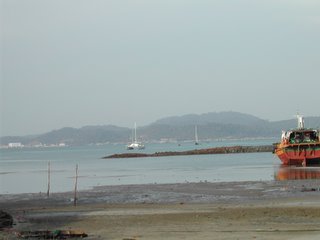

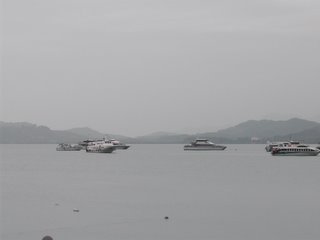
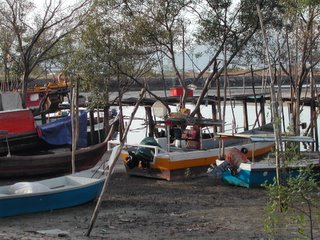

I have just came back from Langkawi Island. It is situated to the north esat of Malaysia, which is northern of Penang Island .I had some work to do i.e to plant dragon fruits. While in Langkawi I shopped around and went to see some scenic places. I bought two sets of stonewares for 8 people. It is quite cheap where all the shops are duty free. The weather was sunny and hot. It has not been raining for the last two or three weeks. I would like to go the hills to get ride on the cable car and to see around the island.
I saw a lot tourists there enjoying the tropical sunlight with light and colourful clothes. They like to come to this place where the beaches are very clean and white.
Monday, January 16, 2006
Hydechyium
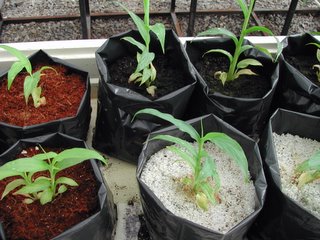
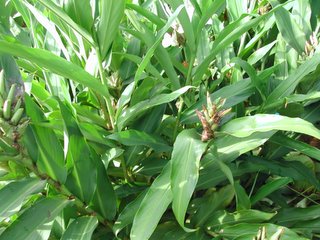
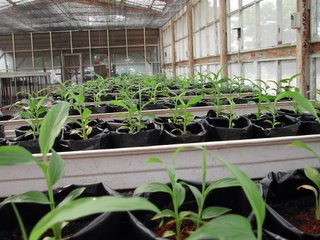
Today is a rainy day.It rains for about an hour. I have to go to the field to continue my heliconia planting.We planted another 5 varieties totalled up 10 varieties ; which we planted under 50% netting. We plan to plant another 10 varieties once we obatained from our order. I will be planting the same 20 varieties in the open field soon plus 10 varieties of canna. I hope every thing will be fine.
Later, I went to see my hedchyium plants that were grown under hydroponics system. It is quite big now.But I see some mutated plants - about 5 plants which looks like ginger plants.the leaves are very narrow and dark green Its stem is cylindrically small. I hope this is a new specie.However my colleague argues that the plants are not strong enough to live. I dont have any idea. Wait till it grows bigger. We grow the plants in cocofibre with 8 hour- interval water cycle.
Sunday, January 15, 2006
Heliconia Planting
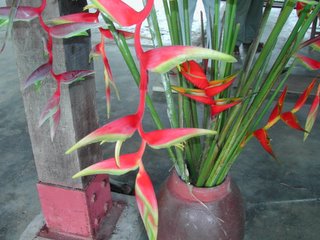
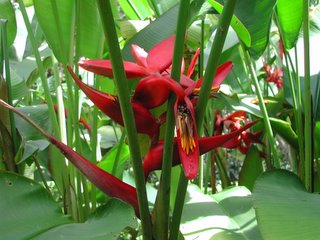
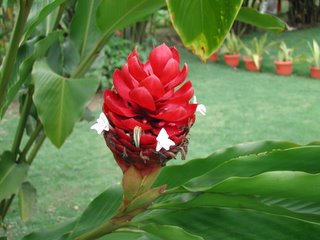
This morning I will be planting heliconias. The weather is fine and sunny. These including tall heliconia varieties like H.charteace (my favourite)- scarlet; tempress; H. carribea; H pupurea; H colliasiana; H Black Magic; H.rauliania; H.borgeana pedro oritz; H.barbados flat. Later I will be panting Siam Tulip (3 varieties).
Initially I have planted 4 heliconias and 2 gingers . These include H. charteace; H.nickerensis; H . jamaican dwarf; H.orthoctrica -She and Eden. They are starting to flowers now. The gingers include red ginger and hydechium are flowering. One of the good point is that the hydechium has very good and sweet smell from its flowers.
Recently I have done fertigation on Hydechium coronarium which is very succesful through tissue culture. We have modified MS solution and these explants are planted in controlled environment.
I will be adding somemore exotic varieties including H.mutisiana; H.emerald (Green heliconia); Prince of Darkness (POD); Globba winitti etc.
My observations was that insect attacks are more prone to heliconias than gingers. Heliconias have bigger leaves than gingers. I have discussed with my fellow friends to extract these ginger chemicals to make bioinsecticides through extraction method.
I have written a paper in Bahasa Malaysia TANAMAN HELIKONIA DAN SEKUTU NYA DIDALAM PERLANDSKAPAN or "Heliconias and its allies for landscaping' Its abstract is here.
Heliconias are one of the fastest growing segments in the diversified horticulture industry in Malaysia. The presence of heliconia and its allies adds up flower diversity and distribution in a landscape area. H. psittacorum cultivars are very popular in the landscape industry due its fast growing, bloom all year round and low maintenance. Some general cultural practices pertaining to heliconia growing such as propagation, irrigation, fertilization and shade requirement are being discussed. Related heliconias and its allied species potential for landscaping are suggested.
Friday, January 13, 2006
Research Collaboration Malaysia-New Zealand
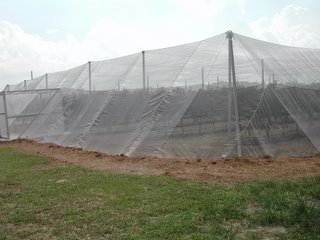
Today I have discussed with my DG about the possibility of arranging research collaboration with NZ research organization.However, they should have a platform to discuss concerning the areas and disciplines that needed to be emphasized. My friend Mr.Zahir Schroder have gone back to NZ and approached HortResearch NZ. They have made further correseponding with us. There are alot of research areas between Malaysia and New Zealand particularly in the agriculture sector needed to be worked out. Malaysia has now engaged agriculture as the 3rd engine of growth so it is very timely that I could make contributions by matching NZ and Malaysian Agricultural Research Institutions.
My hope is that Malaysia could export lot more products to New Zealand and Australia particularly agricultural products because we import a lot from them milk, meat, fruits etc.I dont know what is the trade like but I am pretty sure we are in deficit.
So with this collaboration we try to know each other's country needs and regulations so that trade between the enhanced to the highest level.
Finally; I hope one day I can visit New Zealand to see their agricultural productions as well to see beautiful and scenic places there.
